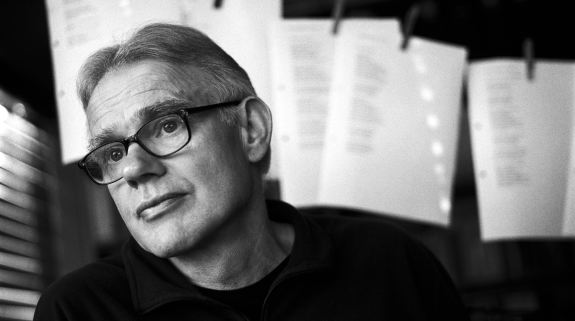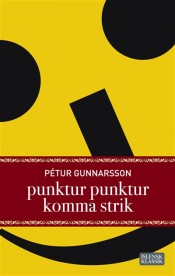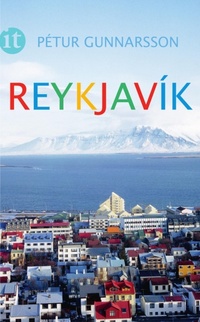Pétur Gunnarsson
“The relationship between authors and their previous works is perhaps best compared to our relationship with dreams. They just disappear into another dimension.”
“The relationship between authors and their previous works is perhaps best compared to our relationship with dreams. They just disappear into another dimension,” says the author Pétur Gunnarsson, who has two books coming out in Germany this year.

Pétur Gunnarsson's debut novel, Dot Dot Comma Dash, (orig. Punktur, punktur, komma, strik) was exceedingly well-received by readers and critics alike on its publication in 1976. A year later, it was added to the reading lists of many Icelandic schools, and from there quickly whisked into the canon of Icelandic literature. The book introduced the young boy Andri Haraldsson to Icelandic readers, who avidly followed the young protagonist's coming of age in postwar Iceland – a journey that would eventually span four books.
The Andri novels introduced a new voice into Icelandic literature – the voice of young Icelanders growing up in the city – or “on the gravel,” to use the Icelandic metonymic term – with urban life as their central experience. The book's supple and evocative prose, in turn, was particularly well-suited to describing to the new kind of reality postwar Icelanders found themselves in.
“...something significant, even wondrous...”
 This year, thirty-five years after the books publication in Iceland, Weidle Verlag published Dot Dot Comma Dash in a translation by Benedikt Grabinski. We decided to have a few words with the author on this occasion. The first thing we want to know is: how does he feel about the book after all these years?
This year, thirty-five years after the books publication in Iceland, Weidle Verlag published Dot Dot Comma Dash in a translation by Benedikt Grabinski. We decided to have a few words with the author on this occasion. The first thing we want to know is: how does he feel about the book after all these years?
“The relationship between authors and their previous works is perhaps best compared to our relationship with dreams,” he replies. “They just disappear into some other dimension. Rather like the dreams that were so real while they lasted, but evaporated as soon as we put on our socks. That's my perspective on Dot Dot Comma Dash. I approach it like any other reader.”
The book became the first well-known example of Pétur's ability to imbue mundane, everyday experiences with cosmic significance. In an essay collection published on the occasion of Pétur's sixtieth birthday, the poet Sigurður Pálsson summed up what he believed was one of the strongest characteristics of Pétur's writings and thought: “His insight is based on a dialectic coalescence of panoramas and close-ups, in a good sense – extreme wide-angle and extreme close-up. For instance, the Earth as viewed from space, versus a candy wrapper.”
In Pocket Book (orig. Vasabók), a journal-like collection of ruminations published in 1989, Pétur wondered if the habit of recording everyday experiences could make us more aware of the significance of the surrounding world. Today, with the omnipresence of social media and other such tools, the everyday has probably never been more extensively recorded. We couldn't resist asking Pétur what he made of all this.
“I always felt that I was experiencing something significant, even wondrous, something in the midst of happening that I wanted to mediate,” Pétur says of the idea behind Pocket Book. “But why dress it up as a novel, necessarily? Why not deliver it as it was, straight from the horse's mouth? Blogging, on the other hand – although I'm not very knowledgable about it, I feel it often lacks this sense of wonder. Maybe it's too everyday?”
“To me, Reykjavík is first and foremost a product of literature”
 As mentioned above, the city is central to Pétur's first novels. Not the city as merely something to compare unfavourably to the countryside, but as a starting-point in itself – a natural centre for the stories he tells. It is therefore fitting that, alongside Dot Dot Comma Dash, another book of his is also being published in Germany, one that dwells more specifically with the city. In Mein Reykjavík, Pétur guides German readers through the streets of Reykjavík, and at the same time, through the city's history, culture and literature.
As mentioned above, the city is central to Pétur's first novels. Not the city as merely something to compare unfavourably to the countryside, but as a starting-point in itself – a natural centre for the stories he tells. It is therefore fitting that, alongside Dot Dot Comma Dash, another book of his is also being published in Germany, one that dwells more specifically with the city. In Mein Reykjavík, Pétur guides German readers through the streets of Reykjavík, and at the same time, through the city's history, culture and literature.
“I was asked to write a “personal book” about Reykjavík,” he says. “Reykjavík as I saw it. To me, Reykjavík is first and foremost a product of literature. It was created in the poems of Tómas Guðmundsson, the poems and prose of Steinn Steinarr, Þórbergur Þórðarson's Savant(orig. Ofvitinn), the short stories of Ásta Sigurðardóttir, the poetry of Dagur Sigurðarson, and so on, all the way up until the authors of today. You see, piling down houses isn't enough. The mental impression is what ultimately matters.”
“Like a miner striking a vein...”
Pétur has never been hesitant to explore new paths in his works. In 2000 he published The Picture of the World (orig. Myndin af heiminum), the first installment in his Novel of Iceland (Skáldsaga um Ísland), an ambitious cycle that now counts three books. They are unusualin that the protagonist is not a human being at all, but Iceland itself. The country's history, origins and evolution are at the story's centre. At the same time, Iceland's relationship with the outside world is explored and underlined, in a style that habitually mixes the mundane and the broadly historical.
“Today's cosmology revolves around two opposite poles – the very large (the theory of relativity) and the very small (quantum theory),” Pétur explains. “Both theories work perfectly well on their own, yet they seem mutually exclusive. The great task at hand is to find a “theory of everything” that encompasses both. Without wanting to compare my own work to something so momentous, I allow myself to hint at the parallels. In any case, cosmology has been my favourite reading material for a long time.”
In the last few years, Pétur has published two biographical works on the Icelandic author Þórbergur Þórðarson. The works have been hailed as invaluable in understanding the life and work of Þórbergur – one of the most beloved, and certainly one of the strangest, authors in Icelandic literature. Now, however, Pétur has a new novel in the works, of which guests of the recent Reykjavík International Literary Festival caught a preview. In conclusion, we asked him: What is it that spurs the writing on?
“A beginning author is fixated on the material: finding something wonderful enough to write about, and the rest should then come easily. But after keeping at it for a long time, the author becomes like a miner striking a vein. The material comes rushing in, and the issue is how to find time, tranquility and a framework to do it justice. I'll be lucky if I live long enough to work my way through everything that is on my mind.”
Interview: Davíð K. Gestsson
English translation: Steingrímur Teague
Photo of author: Kristinn Ingvarsson
